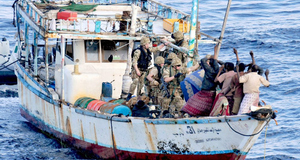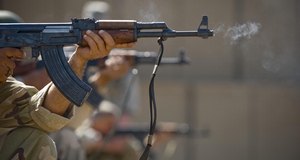Featured Article:The Horn of Africa: Critical Analysis of Conflict Management and Strategies for Success in the Horn's FutureEthiopian InterventionAfter years of unsuccessful UN-sponsored peace conferences in Somalia, Ethiopian forces were rumored to be in there training local militias in support of the Transitional Federal Government (TFG). In December 2006, fighting erupted in Baidoa and Mogadishu between the Ethiopian forces supporting the TFG, and the militias led by clan leaders of the Puntland and the Islamic Courts Union (ICU) that oppose the TFG. News networks reported Ethiopia’s intervention, airing the public rebuke of Ethiopia by the leader of the ICU, Sheik Hassan Dahir Aweys, who declared, “Somalia is in a state of war, and all Somalis should take part in this struggle against Ethiopia,” (CNN 12-2006). This particular statement is of interest because it highlights that there is still an unresolved issue between Somalia and Ethiopia, and that this resentment is potentially strong enough to unite fragmented allegiances to one banner. While it may be encouraging to note that there is hope for aligning scattered loyalties, it must be reiterated that the problem has still not been reconciled between the two nations. Assuming a central government can be reestablished, the problem will likely be framed again in terms of a national issue and another conflict between Ethiopia and Somalia is likely. Following Aweys statement, Ethiopia subsequently stated that it would actively combat the ICU. Ethiopian Prime Minister, Meles Zenawi, additionally attested that they were not intending to “meddle in Somalia affairs” and were only there because they were “forced by the circumstances,” (New York Times 12-2006). By targeting the ICU, Ethiopia was justifying its presence in Somalia. However, this compounded border disputes with Eritrea, whose troops were fighting on behalf of the ICU.Faring little better than the United States or the United Nations, Ethiopian troops withdrew in 2009. That decision followed a two-year insurgency that led to a loss of territory as well as a forced power-sharing deal between the TFG prime minister and an Islamist splinter group, the Alliance for the Re-Liberation of Somalia. The withdrawal of Ethiopian troops, and election of the new Islamist leadership in early 2009, has not brought a conclusion to the conflict. Instead, fighting has merely shifted into a struggle between hard- line Islamist factions and more moderate factions within the government. CONFLICT MANAGEMENT & RESOLUTION IN THE HORNCrises occur when there is a perceived belief in irreconcilable differences between parties. Often, the parties simply have different aims or different interpretations of the change that they want to implement. The primary barrier to resolution in the Horn is that there are “incompatible perceptions of a solution… [and] also because the time has been perceived as ripe for winning, not for resolving.” Throughout the Horn’s conflicts, a “sharp identity [has] prevailed,” and it becomes difficult to “move away from the zero-sum problem of sovereignty and turn to more subtle issues of relations… as a means to make the sum more positive,” (1985 p. 96-99). The sharp identity indicated by Zartman is the fundamental culture of the Horn, which glorifies war and violent behavior. Perhaps this explains why four decades of human rights atrocities and child conscription between Ethiopia and Eritrea has failed to produce any level of anti-war movement. Attitudes are characterized by deception, suspicion, and domination, and this mentality directly inhibits conflict management. Diplomatic Success and Failure in the HornWhat constitutes successful diplomacy in the Horn of Africa? First, distinctions must be made between conflict management and conflict resolution, as there are fundamental differences in success between these two terms. Conflict itself cannot be totally eliminated. However, resolution can be reached through careful analysis of the conflict situation by mediators to help conflicting parties reach goals that no longer conflict. It is rarely accomplished by direct action, and if it occurs, typically is a result of the passing of long periods of time. Conflict management is an effort to prevent conflict from erupting into crisis, or limit the worst excesses of ongoing conflict through mitigation. If a conflict evolves into violence, management is restored through such measures as truce agreements and other conflict settlement, which are historically enacted only after conquest, defeat, or submission. The Horn’s conflicts are long-standing and complex, and success comes in tenuous form. In March 1964, Sudanese good offices brought a ceasefire on the Ethiopian border after inconclusive clashes between the Somali and Ethiopian armies in the Ogaden, showing successful regional management. In the late 1960s, after a change in Somali leadership, border disputes were perceived as a population grievance rather than territorial sovereignty. However, conflict management was not simply the result of a new Somali government; while it was managed under the pretense of a local issue, it was revived when the conflict was again defined in national terms of territory. This demonstrates that mediation can be successful on a regional level as long as a trusted third party can be agreed upon. More importantly, it highlights that the clear definition of party aims allows nations to interact without violence, but relies on continued communication and adequate continuity between leaders. When communication and continuity is not preserved, dormant issues can be revived. In 1973, the OAU Commission of Eight investigated the conflict, but “Ethiopia maintained there was nothing to mediate and Somalia maintained there was nothing to manage.” Hoping to reach an agreement, the commission investigated the possibility of the joint development of an autonomous Ethiopian Ogaden. The OAU attempted to hold hearings, but Somalia walked out and Ethiopia’s call for a special OAU Council of Ministers was never endorsed for “fear that Somalia would leave the organization and carry the Muslim member states with it” (1985 p. 103). This is typical of regional mediation in the region, and illustrates the ineffectiveness of a third party that is unwilling to fulfill its responsibilities. Because regional mediation was generally fruitless, international intervention replaced regional management by the end of the 1970s. The US proposed that Somalia return the border in exchange for Ogaden autonomy, with an international aid program for the Somali inhabitants of the Ethiopian territory. However, the Ethiopian response was typical of the region: no negotiations before victory. Even though Somalia had a significantly smaller army and fewer resources for Ethiopia, Somalia’s armament (first by Russia and later by the United States) made it a viable thorn in Ethiopia’s side. There was no decisive victory and conflict resolution was little more than a ceasefire that took place without mediators. Mediation by regional actors was overshadowed by global interests, which only worsened a conflict with historic roots, denoted by land rights insecurities and local fears of interference. The prolonged war in the Ogaden was clearly a case where the “local conflict dominated global politics…historic opponents sold themselves to global competitors for armaments, and evicted their suppliers and offered themselves again for further military support,” (1985 p. 108). Without superpower intervention, the Ogaden conflict would have ended when the supplies ran out. Evaluating the conflict between Ethiopia and Eritrea, one also finds that the absence of a mutually intolerable stalemate hindered conflict management in the region. Liberation movements were established in Eritrea and in other portions of Ethiopia, such as the Tigre. Any time several parties are involved, it becomes much more difficult for a mediator to offer solutions that satisfy each party’s grievance. In Ethiopia and Eritrea, a bilateral civil conflict transitioned into a multilateral conflict between nation-states and opposition groups, making the conflict more difficult to mediate. The international community was hopeful that the violence between Ethiopia and Eritrea had reached a conclusion in 1993 when Eritrea attained its independence from Ethiopia. Hardly five years passed before violence erupted between the nations with even greater ferocity. The border was never demarcated between the two nations, and UN resolutions to demarcate the border failed to settle the dispute because there were no actions to follow demands. Ethiopia has demonstrated interest in using diplomatic means to resolution, but Eritrea has signaled its desire to continue using military force as its primary means of negotiation. In nearly every conflict within the Horn of Africa, foreign mediators have only exacerbated the problem, not alleviated it. Multi-lateral agencies have failed to make meaningful interventions, and their continued failure means new initiatives are not taken seriously. The international community in particular works off of a concept of legitimacy and peer pressure. In a region where the population is defined by violence, an international slap on the wrist has no resonance, and we cannot expect the international community to provide solutions because there is little repercussion for violent actions besides scrutiny. The Somali civil conflict has led to statewide destabilization and failure, resulting in an economy with little else to offer than lawless capitalism and piracy. Conflict management is of immediate importance to regional and international actors because the destabilization is a threat to regional and international peace. The United Nations’ Unified Task Force intervened in Somalia, as did the United States, but both were unsuccessful. Those missions were aimed at restoring order, but failed when mission creep dictated who would remain in power. Peacekeeping- to- peace enforcing missions only aggravated conflicts between Somali factions, splinter groups, and clan leaders. Both the United States and United Nations left the country without restoring peace or a central government. In Somalia and other countries of the Horn, measureable success will only occur when there is public accountability of the region’s leadership. Only when the people stop accepting violence as the only means to attaining party interests and begin demanding regional support and interdependence, can we expect long-term resolution. For now, the Horn is a culture of war and death, valuing fighting over conciliation, noted by the absence of a call to peace despite decades of atrocities. Until the people demand that accountability, coupled with the space to peacefully dissent, conflict will be difficult to manage and nearly impossible to resolve.Continued on Next Page » Suggested Reading from Inquiries Journal
Inquiries Journal provides undergraduate and graduate students around the world a platform for the wide dissemination of academic work over a range of core disciplines. Representing the work of students from hundreds of institutions around the globe, Inquiries Journal's large database of academic articles is completely free. Learn more | Blog | Submit Latest in International Affairs |


















